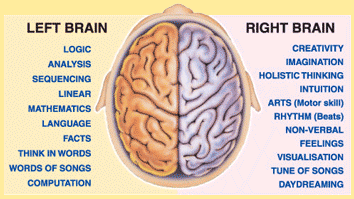Introduction to Objects
> Click or hit Control-Enter to run the code above
Onward
These are the three main challenges that will occupy us for the remainder of the semester:
-
Algorithms: How do we use computers to solve problems?
-
Data structures: How do we structure information to enable efficient algorithms?
-
Software development: How do we write, debug, test, and publish good computer software?
How Do We Structure Good Computer Programs?
-
Break our code into reusable, testable, and understandable pieces
-
Combine state and behavior
-
Document our code appropriately
-
Reuse preexisting solutions as much as possible
-
Share our code with others!
Design
Programming is an intensely creative activity.

Design and Modeling
Java objects begin to expose you to the design aspects of computer science.
Ahead of us there are no right answers, just
-
creativity
-
imagination
-
holistic thinking
-
intuition
-
visualization
Objects
Objects combine state (like variables) and behavior (like functions).
-
What does it store? Objects allow us to structure data in more varied ways than we can achieve with primitive types alone.
-
What does it do? Objects allow us to place methods with the data that they naturally belong with.
Objects: Uniting Algorithms and Data
The two core concerns of computer science.
Object Definition
Object: In the class-based object-oriented programming paradigm, "object" refers to a particular instance of a class where the object can be a combination of variables, functions, and data structures.
Object Terminology: Class
class Person {
String name;
int age;
void printName() {
System.out.println(this.name);
}
}A class determines how a particular type of object will behave.
You can think of the class as a blueprint that is used to create object instances of a particular type.
Object Terminology: Class
class Person {
String name;
int age;
void printName() {
System.out.println(this.name);
}
}Instances of object class Person:
-
Have a variable
nameof typeString -
Have a variable
ageof typeint -
Have a method
printNamethat takes no arguments and returns nothing
Object Terminology: Class
class Person {
String name;
int age;
void printName() {
System.out.println(this.name);
}
}Unlike other languages, Java classes cannot be modified after the program is compiled (at runtime).
-
This is frustrating when writing small programs
-
This is sometimes essential when developing large programs
Object Terminology: Instance
class Person {
String name;
int age;
void printName() {
System.out.println(this.name);
}
}
Person geoffrey = new Person();An instance of a class is an object of that type. We create an instance using
the new keyword.
-
Personis a class—a type of object -
geoffreyis an instance of typePerson
Dot Notation
class Person {
String name;
int age;
void printName() {
System.out.println(this.name);
}
}
Person geoffrey = new Person();
geoffrey.age = 40;
System.out.println(geoffrey.age);We access an object’s state and methods using dot notation.
> Click or hit Control-Enter to run the code above
Instance Variables
class Dimensions {
int width; // I'm a primitive type
int height;
}
class Room {
String name; // I'm another object
Dimensions dimensions; // I'm defined above
}
Room diningRoom = new Room();
diningRoom.dimensions = new Dimensions();
diningRoom.dimensions.width = 10;Instance variables can be both primitive types or other objects.
> Click or hit Control-Enter to run the code above
Objects as Custom Types
Java objects allow us to define our own types built from the primitive types we’ve already discussed.
This dramatically improves our ability to work with real-world data.
Custom Types: Location
Remember MP0?
public static int getTargetWithinRange(final double[] latitudes, final double[] longitudes, final int[] path,
final double currentLatitude, final double currentLongitude, final int range) {
// HINT: To find the distance in meters between two locations, use a provided helper function:
// LatLngUtils.distance(oneLatitude, oneLongitude, otherLatitude, otherLongitude)
return -1;
}Custom Types: Location
public static int getTargetWithinRange(final double[] latitudes, final double[] longitudes, final int[] path,
final double currentLatitude, final double currentLongitude, final int range) {
// HINT: To find the distance in meters between two locations, use a provided helper function:
// LatLngUtils.distance(oneLatitude, oneLongitude, otherLatitude, otherLongitude)
return -1;
}Synchronized indices is the wrong solution to this problem 1!
What do we really want?
-
One location type that stores
-
a latitude
-
a longitude
-
and whether it is valid or not
Custom Types: Location
class Location {
double latitude;
double longitude;
boolean isValid;
}
public static int getTargetWithinRange(final Location[] path,
final Location currentLocation, int range) {
return -1;
}Objects as Data Structures
Sometimes known as records—but objects are much more than that…
Instance Methods
class Dimensions {
int width;
int height;
int area() {
return this.width * this.height;
}
}
Dimensions example = new Dimensions();
example.width = 10;
example.height = 20;
System.out.println(example.area());Classes can also define methods that can be called on each instance.
> Click or hit Control-Enter to run the code above
this
class Dimensions {
int width;
int height;
int area() {
return this.width * this.height;
}
}Instance methods can refer to their instance variables using the this
keyword.
this refers to the instance that is executing the method.
> Click or hit Control-Enter to run the code above
Object Modeling
We frequently use Java objects to model real objects or entities.
Objects allow us to design software that deals with things in realistic and natural ways.
Midterm Reminder
-
12 multiple-choice questions, mostly on code reading
-
3 programming questions:
-
one using arrays,
-
one using multi-dimensional arrays,
-
and one using strings.
-
-
One programming question will be drawn directly from the HW125 practice problems. So use those to prepare.